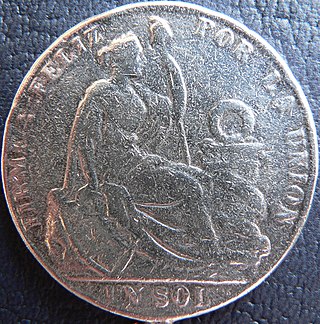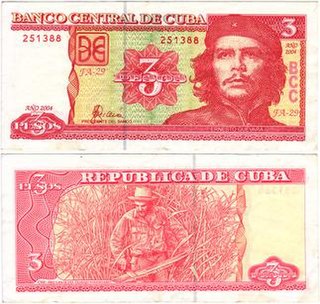
The peso (local name peso fuerte) was a currency of Venezuela until 1874. It was subdivided into 10 reales, each of 10 centavos .

The peso (local name peso fuerte) was a currency of Venezuela until 1874. It was subdivided into 10 reales, each of 10 centavos .
Until 1821, the Spanish colonial real circulated in Venezuela. Some of these coins were minted at the Caracas Royal Mint (Spanish: Real Casa de Moneda de Caracas) established in 1802. Coins minted in Caracas were called Venezuelan reales. On 27 August 1811, with the United States of Venezuela (Estados Unidos de Venezuela) having declared their independence, the recently established Supreme Congress of Venezuela (Congreso Supremo de Venezuela) establishes the peso with an equivalence of 8 reales to 1 peso and an initial issue of one million pesos in paper money. [2]
Since no lower denominations or metallic coins had been issued; foreign, low-value coins circulated alongside the peso in Venezuela. [2] In particular, with the establishment of the Colombian real in 1820 came its circulation in Venezuela the following year. Indeed, as part of Gran Colombia, the Caracas mint would issue Colombian reales starting in 1821, [3] which would continue to circulate even after Venezuela separated from Gran Colombia. On 28 March 1835, the Congress of Venezuela acknowledged these uses de jure and granted the United States Penny legal tender status within Venezuela. The Colombian real remained in use until 1837 (when it was replaced by the Colombian peso).
On 29 March 1842, the Congress of Venezuela ordered the minting of 1, ½, and ¼ centavo coins, putting an end to the use of foreign coins for this purpose. [2] To define the value of these smaller coins, the peso was subdivided into 10 reales, each of 10 centavos , following the suit of the Colombian currency. [4] The coins would not be seen in circulation until the following year, for which reason they are generally referred to as the "1843 coins". All other denominations would be approved by Congress on 1 April 1854. [2]
The peso was substituted in 1871 by the venezolano, although it wouldn't enter circulation until 18 June 1874. [2] Finally, in 1879, the bolívar was introduced.
In 1843, copper coins were introduced in denominations of ¼, ½ and 1 centavo. These were followed in 1858 by silver ½, 1, 2 and 5 reales. In 1863, silver 10-real (1-peso) coins were issued, although most were later melted. [4]
In 1811, the Estados Unidos de Venezuela issued notes in denominations of 2 reales, 1, 2, 4, 5 and 10 pesos. In 1849, the Treasury issued notes for 5 pesos, which were followed by government issues for 5, 10, 50, 100, 500 and 1000 pesos from 1859. From 1860, notes for 8 reales and 20 pesos were issued. [3]
| Preceded by: Real Reason: establishment of national currency Ratio: 8 reales = 1 peso fuerte | Currency of Venezuela 27 August 1811 – 18 June 1874 | Succeeded by: Venezolano Reason: coin quality Ratio: 1 peso fuerte = 1 venezolano |
The peso is the currency of Argentina since 1992, identified within Argentina by the symbol $ preceding the amount in the same way as many countries using peso or dollar currencies. It is subdivided into 100 centavos, but due to rapid inflation, coins and notes with a value lower than 500 pesos are now rarely used. Its ISO 4217 code is ARS. It replaced the austral at a rate of 10,000 australes to one peso.

The córdoba is the currency of Nicaragua and is divided into 100 centavos.

The sol, later sol de oro, was the currency of Peru between 1863 and 1985. It had the ISO 4217 currency code PES. It was subdivided into 10 dineros or 100 centavos. It also had two different superunits over its circulation life, the inca (1881–1882) and later the gold pound, both worth 10 soles.

The Colombian peso is the currency of Colombia. Its ISO 4217 code is COP. The official peso symbol is $, with Col$. also being used to distinguish it from other peso- and dollar-denominated currencies.

The Cuban peso also known as moneda nacional, is the official currency of Cuba.

The Dominican peso, officially the peso dominicano since 2010, is the currency of the Dominican Republic. Its symbol is "$", with "RD$" used when distinction from other pesos is required; its ISO 4217 code is "DOP". Each peso is divided into 100 centavos ("cents"), for which the ¢ symbol is used. With exception of the United States dollar, it is the only currency that is legal tender in the Dominican Republic for all monetary transactions, whether public or private.
The boliviano is the currency of Bolivia. It is divided into 100 cents or centavos in Spanish. Boliviano was also the name of the currency of Bolivia between 1864 and 1963. From April 2018, the manager of the Central Bank of Bolivia, Pablo Ramos, announced the introduction of the new family of banknotes of the Plurinational State of Bolivia, started with the 10 Bs note, and then gradually arrived to introduce the 200 Bs note, presented in April 2019. The new family of banknotes of the Plurinational State received several awards such as "the best banknotes in Latin America", was highlighted by its security measures, its aesthetics and its inclusion of prominent figures in Bolivian history, being among those who awarded the "Latin American High Security Printing Press Conference".

The peso was the currency of Costa Rica between 1850 and 1896. It was initially subdivided into 8 reales and circulated alongside the earlier currency, the real, until 1864, when Costa Rica decimalized and the peso was subdivided into 100 centavos. The peso was replaced by the colón at par in 1896

The venezolano was the currency of Venezuela between 1872 and 1879. It was divided into 100 centavos, although the names céntimo and centésimo were also used. Venezolano was also the name of two currencies planned in 1854 and 1865.
The real was the currency of Argentina until 1881. From 1822, it was subdivided into 10 décimos. The sol was also issued during this period and was equal to the real, whilst the peso was worth 8 reales and the escudo was worth 16 reales.

The real was the currency of Colombia until 1837. No subdivisions of the real existed until after the real had ceased to be the primary unit of currency. However, 8 reales = 1 peso and 16 reales = 1 escudo.

The peso was a currency of Ecuador until 1884.

The currencies of Puerto Rico closely follow the historic development of the territory. As a Province of Spain and a territory of the United States, Puerto Rico was granted the use of both foreign and provincial currencies. Following the Spanish colonization in 1508, Puerto Rico became an important port, with its own supply of gold. However, as the mineral reserves ran empty within the century, the archipelago's economy suffered. The Spanish Crown issued the Situado Mexicano, which meant that a semi-regular shipment of gold from the Viceroyalty of New Spain would be sent to the island, as a way to provide economic support. Between 1636 and 1637, Philip IV of Spain imposed a tax which had to be paid using a revenue stamp. Inspired by this, Puerto Rico began producing banknotes in 1766, becoming the first Overseas Province to print 8-real banknotes in the Spanish Empire and which in the Spanish government's approval of subsequent issues.
The peso moneda nacional was the currency of Argentina from 5 November 1881 to 1 January 1970, the date in which the peso ley 18.188 was issued to the Argentine public. It was subdivided into 100 centavos, with the argentino worth 5 pesos. The peso was introduced to replace the Argentine peso moneda corriente at a rate of $+m⁄c 25 = m$n 1.
The real was the currency of Venezuela until 1843.

This is an outline of Uruguay's monetary history. For the present currency of Uruguay, see Uruguayan peso.

The currency of Venezuela has been in circulation since the end of the 18th century. The present currency unit in Venezuela is the Venezuelan bolívar.
Currency in Colombia denotes the ingots, coins, and banknotes that have been used in Colombia since 1622. It was in that year, under a licence purchased from King Philip III of Spain, that Alonso Turrillo de Yebra established a mint at Santa Fe de Bogotá and a branch mint at Cartagena de las Indias, where gold cobs were produced as part of Colombia's first currency. Silver milled coins date from 1627. In 1831, Gran Colombia dissolved into Venezuela and New Granada. In 1836, in New Granada, new monetary laws were passed, to standardise the money produced in the country. From 1861 to 1862, due to financial instability, the United States of New Granada accepted British currency, the name of the country becoming the United States of Colombia in 1862. In 1880, Colombia pegged the peso to the gold standard due to the falling price of silver. In 1886, the paper peso was introduced. In 1931, Colombia abandoned the gold standard and switched to the current form of the peso.
This article provides a historical summary of the currency used in Ecuador. The present currency of Ecuador is the United States dollar.

The Coins of the Venezuelan venezolano circulated between 1874 and 1897. On June 11, 1873, the government ordered subsidiary silver coins of 5, 10, 20, and 50 centésimos de venezolano from Paris. An order for gold coins was placed on September 16, 1874, originally for pieces of 1, 5, 10, and 20 venezolanos, the 20-venezolano gold piece to be called the Bolívar. This order was subsequently altered to a silver 1 venezolano and a gold 5 venezolanos. The dies for the coins produced in Paris were engraved by Albert Désiré Barre, chief engraver of the Paris Mint (1855–1878).